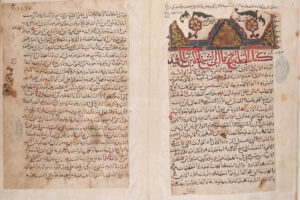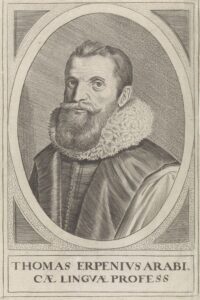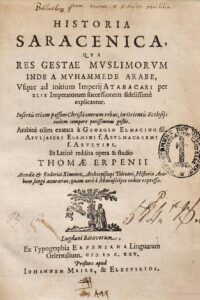Christian Arabs as cultural mediators: al-Makīn Ibn al-ʿAmīd and his Universal History
When the 13th-century Coptic official Ibn al-ʿAmīd was thrown into prison by Sultan Baybars, he set out to compile a summary of universal history from the creation to his own days. His work was to become one of the major instances of Christian-Muslim intellectual exchange in the pre-modern era.
In October 1264, al-Makīn Ibn al-ʿAmīd was languishing in prison. A member of a distinguished family of Coptic notables, born in Cairo in 1206, he had risen through the echelons of the state administration, first in Egypt and then in Syria, until he had been assigned an important position in the Department of the Army (Dīwān al-jaysh) under al-Nāṣir Yūsuf, the Ayyubid Emir of Aleppo and Damascus. But the short-lived Mongol occupation of Damascus in 1260 and the ill-advised attitude of Ibn al-ʿAmīd’s nephew at this critical juncture precipitated his fall. In 1262, two years after the Mamluk reconquest of Syria, he experienced a first period of disgrace: Sultan Baybars summoned him to Egypt and had him chastised. Yet, in a strange twist of fate, Ibn al-ʿAmīd was soon released and even promoted to chief administrator of the army in both Egypt and Syria. Shortly thereafter, however, he was accused of conspiring with the Mongols and arrested again. Although the charge was probably fabricated by a rival scribe, his career was ruined, and he spent more than 10 years in prison. After his release, he retired to private life and died in Damascus, possibly in 1293.
On October 23, 1264, Ibn al-ʿAmīd began to write a universal history, from the creation to his own days, which he entitled simply Kitāb al-Taʾrīkh, “Book of History.” Was he seeking distraction or perhaps consolation from his misery? We don’t know, for the author is very discreet about himself. What we do know, however, is that his work was to enjoy wide popularity not only among Eastern Christians, but also among Muslim historians and early modern European Arabists.
A well-assorted compilation
Technically speaking, Ibn al-ʿAmīd’s book is a universal chronography, i.e., an account of past events arranged in loose chronological order according to a succession of characters. First devised by Julius Africanus (ca. 160–240), this genre became very popular in Late Antiquity, especially in Greek and Syriac milieus. By merging sacred, secular, and ecclesiastical history in a continuous narration from the creation to the present, it served the interests of various categories of readers. After the Arab conquest, chronographies were also produced in Arabic, mainly by Melkite authors, such as Eutychius (d. 940) and Agapius (d. after 942), and later also by Eastern and Western Syriac authors, such as Elias of Nisibis (d. 1046) and Bar Hebraeus (d. 1286). By contrast, and with a sole exception, Coptic scholars did not practice this genre until the 13th century, when the reunification of Syria and Egypt under the Ayyubids created a new cultural atmosphere. Exchanges between Cairo and the Bilād al-Shām became much easier and a circle of Coptic intellectuals, the Awlād al-ʿAssāl, took the lead in an intense cultural revival, the so-called Coptic Renaissance. This revival was also favored by the emergence of Arabic as the lingua franca of the entire region. As a result, many works produced by Christians of other denominations, as well as Jews and Muslims, came to enrich the Copto-Arabic library.
A first fruit of this revival was the Kitāb al-Tawārīkh. Completed in 1257 by the Egyptian monk Ibn al-Rāhib, it dealt with the different calendars that were in use in the Middle East at his time and the way to determine the Christian festivals. It also contained a series of chronological tables which were arranged in 166 rows from Adam to Heraclius for the pre-Islamic period, and according to the succession of caliphs, kings, and sultans for the Islamic epoch, from Muḥammad to the author’s days.
Ibn al-ʿAmīd took the next step. While following Ibn al-Rāhib in his chronological arrangement, he supplemented it with a historical narrative, by summarizing, for the pre-Islamic section, the Melkite chronologies of which he gained knowledge in Damascus. Moreover, he benefitted from a little-known surge in Biblical studies. As shown by Ronny Vollandt, while the Coptic Church initially relied on a poor-quality Arabic version of the Septuagint, the Awlād al-ʿAssāl had the text revised through a comparison with Saadiah’s Tafsīr, i.e., the most authoritative Judeo-Arabic interpretative translation of the Hebrew Bible, produced by the Egyptian Rabbi Saadiah Gaon (d. 942). In addition to these sources, Ibn al-ʿAmīd also came across “Rūzbihān’s History,” a Seljukid mirror for princes set in a fictionalized pre-Islamic Persia. He mistakenly read it as an authentic document of ancient history and hastened to include it in his chronography. Finally, our author was interested in Hermetic texts, of which he quoted some excerpts, especially in the chapter on Alexander the Great. As far as the Islamic section is concerned, Ibn al-ʿAmīd mostly relied on his contemporary Ibn Wāṣil’s universal history, a compendium and a continuation of al-Ṭabarī, simply supplementing some notes concerning the Coptic Patriarchs.
To this vast array of sources, which is consistent with the intellectual curiosity and the ecumenical attitude of the Awlād al-ʿAssāl and their circle, Ibn al-ʿAmīd also added his personal contribution. This is particularly apparent in the list of 30 World Wonders (ch. 15) and the portion devoted to Ayyubid history, in which Ibn al-ʿAmīd’s account becomes “more detailed and of vastly superior originality” (thus Claude Cahen, who edited it in 1957). Nevertheless, his authorial will is present throughout the work, governing the assembling of these various sources into a coherent and orderly synthesis.


The “Historian of the Christians”
It was probably these qualities of clearness and (relative) conciseness that explained the work’s enduring popularity. Its success is attested to by the sheer number of preserved manuscripts: 29 for the pre-Islamic section, of which I inspected 25 for my edition, and at least 15 for the Islamic part. They reflect different recensions, which ultimately go back to the author.
Through a detailed study of the manuscripts’ reading- and ownership notes I was able to illustrate how the Kitāb al-Taʾrīkh soon spread outside Egypt, in Syria and Lebanon. It also reached Ethiopia, where the History of Wäldä Amid (as our author became known) was translated at least twice, between the 15th and the 16th century. But by far the most interesting aspect in the work’s fortune is its reception among Muslim intellectuals. Five cases have been identified so far. Among them, one stands out: our Coptic author was extensively read by Ibn Khaldūn, who quoted him more than 70 times in the second part of his Kitāb al-ʿIbar (“Book of Lessons”).
The Maghrebi scholar, who bestowed the resounding title of “Historian of the Christians” on his predecessor, gained access to the Kitāb al-Taʾrīkh in Egypt, where he lived nearly a quarter of a century, from 1382 to his death in 1406. In fact, in the last part of his life, Ibn Khaldūn set out to turn the Kitāb al-ʿIbar into a true world history, perhaps the first of its kind. To attain this aim, he needed more information about Biblical, Jewish, Graeco-Roman, and early Christian history, and it is mainly in Ibn al-ʿAmīd’s work that he found it. Ibn Khaldūn quoted our Coptic historian together with the Josippon (a reworked version of Josephus’s Jewish War) and the Arabic Orosius. By doing so, he harmonized Byzantine and Latin historiography into a single presentation of the Graeco-Roman past, for the first time in Arabic culture. Thus, Ibn al-ʿAmīd, next to the Josippon
and the Arabic Orosius, proved instrumental in enlarging the horizons of the Maghrebi historian. The same holds true for Ibn Khaldun’s disciple al-Maqrīzī, who again relied on the same three sources for ancient history. In particular, and as demonstrated by Mayte Penelas, al-Maqrīzī regarded Ibn al-ʿAmīd as an authority for Coptic and early Christian history, and this despite the marked animosity towards Egyptian Christians that he harbored.
It is generally assumed that Muslim scholars were not cognizant of the Bible, given their reservations towards its textual integrity, and preferred to rely on oral traditions transmitted by Jewish and Christian converts. Yet, a reading of Ibn Khaldūn or al-Maqrīzī in conjunction with Ibn al-ʿAmīd shows that some of them were familiar with the historical narrative underlying the Old and New Testament, as mediated by Christian Arab authors. In other words, Muslim historians from the Mamluk period knew the Bible more than it is usually assumed and some of them used it as a reliable document, as long as it did not clash with the Qur’anic presentation of the same events. In view of the persistent polemics surrounding the Biblical text in the Islamic world, this is not a minor finding.
From Ibn al-ʿAmīd to Elmacinus
Roughly two and a half centuries after Ibn Khaldūn, Ibn al-ʿAmīd came to the fore again, this time in the Netherlands, thanks to Thomas Erpenius (1584–1624). The Dutch Arabist was looking for some teaching materials for the chair of Arabic that had just been established in Leiden. His original plan was to travel to the Levant to collect some new codices, but he could not proceed any further than Venice. On his way back to Leiden, empty-handed, he stopped in Heidelberg, where he found a manuscript containing the Islamic section of Ibn al-ʿAmīd’s history—how it had arrived there is another intriguing story involving the French humanist and Kabbalist Guillaume Postel (1510–1581). Postel had acquired the codex during his second sojourn in the Levant (1549–1550), as an envoy of the king of France, and annexed much importance to it. But starting from 1547 Postel began to give signs of mental imbalance; suspected of heresy and in dire financial need, he was forced to sell all his Arabic manuscripts, including Ibn al-ʿAmīd’s chronography, to the Elector Palatine Otto-Heinrich (1502–1559).

Some fifty years after Postel’s misadventure, Ibn al-ʿAmīd’s chronography immediately caught Erpenius’s attention: the Dutch Arabist borrowed the manuscript for 200 thalers, with a pledge to return it to the Palatine library. Soon after, however, the Thirty Years’ War broke out, the Library was moved from Heidelberg to Rome, and Erpenius considered himself absolved from his oath. In Leiden, he began to edit the text with a parallel Latin translation. This was a pioneering attempt, not lastly in its materiality, for the Dutch Arabist had to carve the Arabic printing type himself. Yet, he was not lucky enough to see his own achievement, since he prematurely died in the Great Plague of 1624. It was his disciple Jacob Golius (1596–1667) who continued the edition until a suitable stopping point, for which he chose a page roughly two thirds into the Islamic part of the Kitāb al-Taʾrīkh where Ibn al-ʿAmīd related his family history. Golius also supervised the impression of the book in 1625.

Elmacinus’s Historia Saracenica, as Erpenius entitled it, was a breakthrough in European culture, quenching the thirst for more objective information about the Islamic world. In subsequent decades, it was translated into English and French, and Elmacinus remained a standard reference until Edward Gibbon (1737–1794). By contrast, European Arabists were less interested in the first part of Ibn al-ʿAmīd’s history: they did not need to read our Copto-Arabic historian to learn about Alexander the Great, August, or Constantine. For this reason, and despite some early attempts by the Swiss Orientalist Johann Heinrich Hottinger (1620–1667) and more recently by Gaston Wiet and Michel Breydy, the pre-Islamic part of Ibn al-ʿAmīd is being edited just now. In 2023, I published the portion stretching from Adam to the end of the Achaemenids with parallel English text and an extensive introduction and I hope that the section from Alexander the Great to Heraclius might see the light of day in 2025, exactly four hundred years after Erpenius’s edition (and again in Leiden!).
Many elements could be added to the fascinating history of this universal history, which successfully mediated Biblical, Late Antique, and Islamic materials to readers as diverse as Christian Arab scholars, Muslim historians, and early modern Protestant and Catholic Arabists. But I hope that even this short overview may convey a sense of how Ibn al-ʿAmīd/Wäldä Amid/Elmacinus worked as a cultural mediator, a passeur de cultures. In his multiple avatars, he has still something to say to our interconnected world.
Martino Diez, Ph.D. (2007), is associate professor of Arabic Language and Literature at the Catholic University of Milan and scientific director of the Oasis International Foundation. In 2019 he was a visiting member to the Institute for Advanced Study, School of Historical Studies, where he began to work on Ibn al-ʿAmīd’s Universal History. He has just critically edited its first portion, from Adam to the end of the Achaemenids (Leiden/Boston: Brill, 2023).

